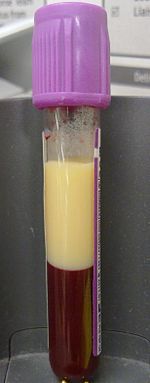
Back عسر شحميات الدم Arabic Dislipèmia Catalan Fettstoffwechselstörung German Dislipidemia Spanish دیسلیپیدمی Persian Dyslipidémie French Dislipidemija Croatian Դիսլիպիդեմիա Armenian Dislipidemia ID Dislipidemia Italian
| Dyslipidemia | |
|---|---|
 | |
| An example of dyslipidemia in the form of a 4-ml sample of hyperlipidemic blood in a vacutainer with EDTA. Left to settle for four hours without centrifugation, the lipids separated into the top fraction. | |
| Specialty | Cardiology |
| Symptoms | Atherosclerosis |
| Complications | Cardiovascular disease, coronary artery disease |
| Types | Hyperlipidemia, hypolipidemia |
Dyslipidemia is a metabolic disorder characterized by abnormally high or low amounts of any or all lipids (e.g. fats, triglycerides, cholesterol, phospholipids) or lipoproteins in the blood.[1] Dyslipidemia is a risk factor for the development of atherosclerotic cardiovascular diseases,[1] which include coronary artery disease, cerebrovascular disease, and peripheral artery disease.[1] Although dyslipidemia is a risk factor for cardiovascular disease, abnormal levels do not mean that lipid lowering agents need to be started.[2] Other factors, such as comorbid conditions and lifestyle in addition to dyslipidemia, is considered in a cardiovascular risk assessment.[3] In developed countries, most dyslipidemias are hyperlipidemias; that is, an elevation of lipids in the blood. This is often due to diet and lifestyle. Prolonged elevation of insulin resistance can also lead to dyslipidemia.[1]
- ^ a b c d Dixon, Dave L; Riche, Daniel M (April 21, 2021). "Dyslipidemia". Pharmacotherapy:A Pathophysiological Approach, 11e. Book authored by Joseph T. DiPiro, Gary C. Yee, L. Michael Posey, Stuart T. Haines, Thomas D. Nolin, Vicki Ellingrod. Archived from the original on 2020-08-08.
- ^ Rosenson, Robert S; Eckel, Robert H (April 9, 2021). "Hypertriglyceridemia". UpToDate. Retrieved April 21, 2021.
- ^ Wilson, Peter WF (March 29, 2020). "Cardiovascular disease risk assessment for primary prevention in adults: Our approach". UpToDate. Retrieved April 22, 2021.